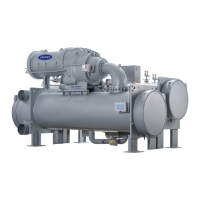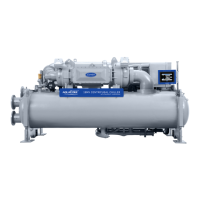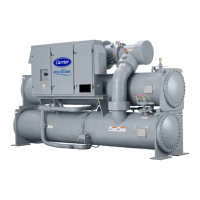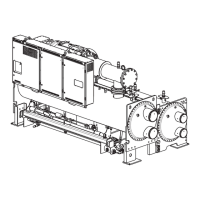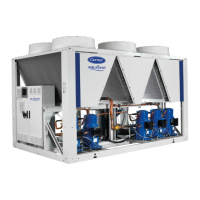97
Checking Display Messages — The first area to
check when troubleshooting the 23XRV chiller is the ICVC
display. If the alarm light is flashing, check the primary and
secondary message lines on the ICVC default screen (Fig. 24).
These messages will indicate where the fault is occurring.
These messages contain the alarm message with a specified
code. This code or state appears with each alarm and alert mes-
sage. The ALARM and ALERT HISTORY tables on the ICVC
SERVICE menu also contain a message to further expand on
the fault condition. Note that the date format in these tables is
MM/DD/YY. For a complete list of possible alarm messages,
see Table 19. If the alarm light starts to flash while accessing a
menu screen, press the softkey to return to the default
screen to read the alarm message. The STATUS screen can also
be accessed to determine where an alarm exists. A “C” to the
right of a parameters value means there is a communications
fault on that channel.
Checking Temperature Sensors — Except for the
motor temperature sensors, all temperature sensors are installed
in thermowells. This eliminates the need to drain the refriger-
ant, oil, or liquid from the chiller to replace the sensor. All
temperature sensors are thermistor-type sensors. This means
that the resistance of the sensor varies with temperature. All
sensors have the same resistance characteristics.
RESISTANCE CHECK — Turn off the control power and,
from the module, disconnect the terminal plug of the sensor in
question. With a digital ohmmeter, measure sensor resistance
between receptacles as designated by the wiring diagram.
The resistance and corresponding temperature are listed in
Table 21 or 22. Check the resistance of both wires to ground.
This resistance should be infinite.
VOLTAGE DROP — The voltage drop across any energized
sensor can be measured with a digital voltmeter while the
control is energized. Table 21 or 22 lists the relationship be-
tween temperature and sensor voltage drop (volts dc measured
across the energized sensor). Exercise care when measuring
voltage to prevent damage to the sensor leads, connector plugs,
and modules. Sensors should also be checked at the sensor
plugs. Check the sensor wire at the sensor for 5 vdc if the con-
trol is powered on.
CHECK SENSOR ACCURACY — Place the sensor in a
medium of known temperature and compare that temperature
to the measured reading. The thermometer used to determine
the temperature of the medium should be of laboratory quality
with 0.5º F (.25º C) graduations. The sensor in question should
be accurate to within 2º F (1.2º C).
See Fig. 5-7 for sensor locations. Temperature sensors are
inserted into a thermowell in the refrigerant or liquid circuits.
When installing a new sensor thermowell, apply a pipe sealant
or thread sealant (RCD part number 56507) to the thermowell
threads. Coat the temperature sensors with thermally conduc-
tive grease (RCD Part Number PP8024) before inserting into
the thermowell.
DUAL MOTOR TEMPERATURE SENSORS — For ser-
vicing convenience, there are 2 sensors on the motor tempera-
ture sensor. If one of the sensors is damaged, the other can be
used by simply moving a wire. The number 2 terminal in the
sensor terminal box is the common line. To use the second sen-
sor, move the wire from the number 1 position to the num-
ber 3 position.
Checking Pressure Transducers — There are as
many as 9 pressure transducers on 23XRV chillers. They deter-
mine EVAPORATOR PRESSURE, CONDENSER PRESSURE,
oil pressure leaving filter, oil sump pressure, DISCHARGE
PRESSURE, and optional CHILLED LIQUID DELTA P and
CONDENSER LIQUID DELTA P. The EVAPORATOR PRES-
SURE and CONDENSER PRESSURE transducers are also
used by the PIC III to determine the refrigerant temperatures.
The OIL PRESSURE DELTA P (oil pressure leaving filter – oil
sump pressure) is calculated by the CCM.
All pressure transducers should be calibrated prior to initial
start-up. At high altitude locations, it is necessary to calibrate
the transducers to ensure the proper refrigerant temperature/
pressure relationship. Each transducer is supplied with 5 vdc
power from the CCM. If the power supply fails, a transducer
voltage reference alarm (239) is declared. If the transducer
reading is suspected of being faulty, check the TRANSDUCER
VOLTAGE REF supply voltage. It should be 5 vdc ± .5 v
displayed in CONTROL TEST under PRESSURE TRANS-
DUCERS. If the TRANSDUCER VOLTAGE REF is correct,
the transducer should be recalibrated or replaced.
Also check that inputs on CCM J5-1 through J5-6 have not
been grounded and are not receiving anything other than a 4 to
20 mA signal.
COOLER CONDENSER PRESSURE TRANSDUCER
AND OPTIONAL WATER SIDE PRESSURE TRANS-
DUCER CALIBRATION — Calibration can be checked by
comparing the pressure readings from the transducer to an
accurate refrigeration gage reading. These readings can be
viewed or calibrated from the HEAT_EX screen on the ICVC.
The transducer can be checked and calibrated at 2 pressure
points. These calibration points are 0 psig (0 kPa) and between
25 and 250 psig (173 and 1724 kPa). To calibrate these trans-
ducers:
1. Shut down the compressor, cooler, and condenser pumps.
NOTE: There should be no flow through the heat
exchangers.
2. Disconnect the transducer in question from its Schrader
fitting for cooler or condenser transducer calibration. For
oil pressure delta P, the optional cooler and condenser
liquid delta P, or flow device calibration, leave the trans-
ducer in place.
NOTE: If the cooler or condenser vessels are at 0 psig
(0 kPa) or are open to atmospheric pressure, the transduc-
ers can be calibrated for zero without removing the
transducer from the vessel.
3. Access the HEAT_EX (or the ECON_EXV for ECONO-
MIZER PRESSURE for P compressor with economizer
option) screen and view the particular transducer reading
(the EVAPORATOR PRESSURE or CONDENSER
PRESSURE parameter on the HEAT_EX screen). To cal-
ibrate oil pressure or water side pressure transducer, view
the particular reading (CHILLED LIQUID DELTA P and
CONDENSER LIQUID DELTA P on the HEAT_EX
screen, and OIL PRESSURE DELTA P on the COM-
PRESS screen). It should read 0 psi (0 kPa). If the reading
is not 0 psi (0 kPa), but within ± 5 psi (35 kPa), the value
may be set to zero by pressing the softkey
while the appropriate transducer parameter is highlighted
on the ICVC screen. Then press the softkey.
The value will now go to zero. No high end calibration is
necessary for OIL PRESSURE DELTA P, optional
CHILLED LIQUID DELTA P
or CONDENSER LIQUID
DELTA P or for flow devices.
If the transducer value is not within the calibration range,
the transducer returns to the original reading. If the pres-
sure is within the allowed range (noted above), check the
voltage ratio of the transducer. To obtain the voltage ratio,
divide the voltage (dc) input from the transducer (white
wire to black wire) by the TRANSDUCER VOLTAGE
REF supply voltage signal (displayed in CONTROL
TEST menu in the PRESSURE TRANSDUCERS

